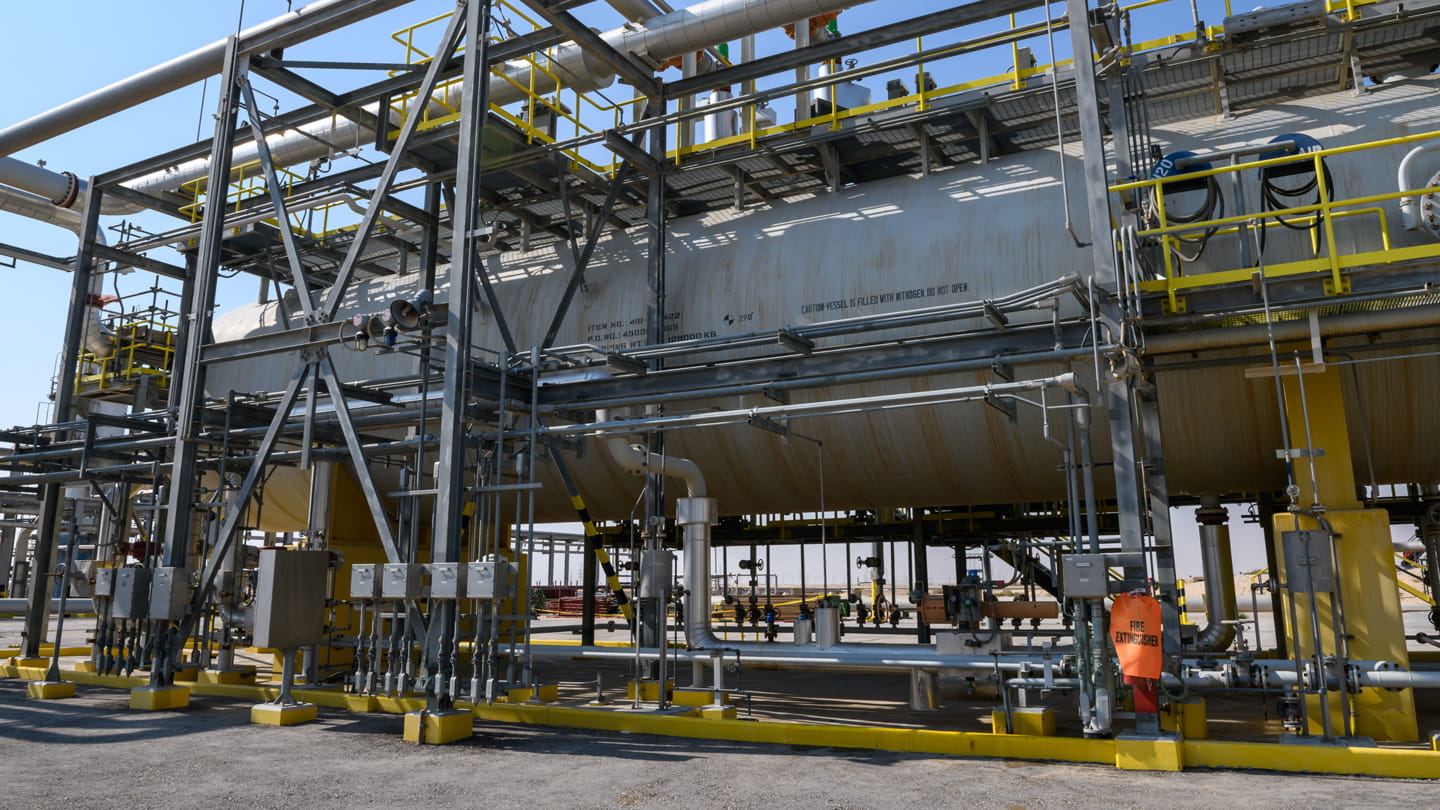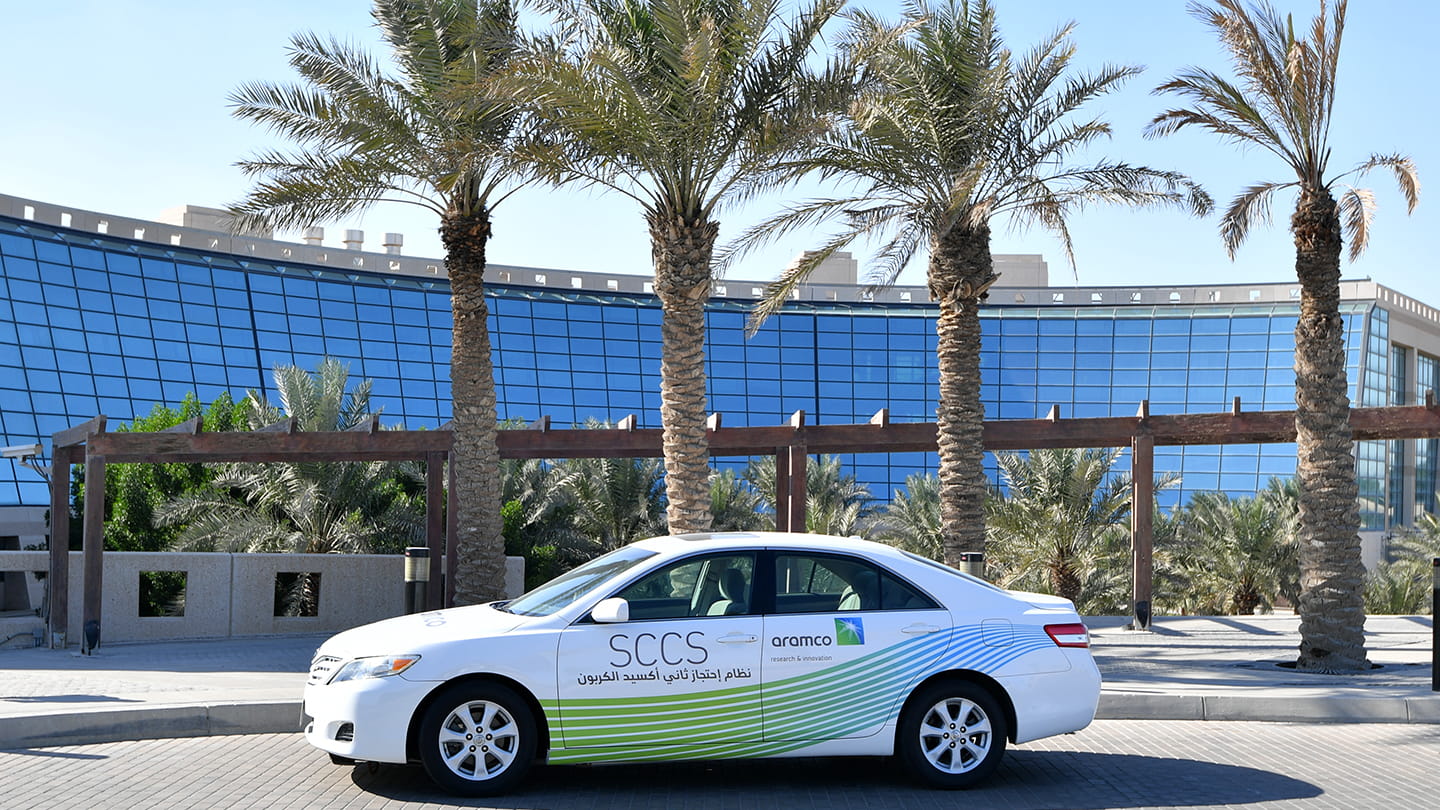
Carbon capture, utilization, and storage
At Aramco we believe carbon capture, utilization, and storage (CCUS) will play a key role in global efforts to reduce emissions.

How does CCUS work?
CCUS technologies capture CO2 emissions at source or directly from the air. The captured emissions are then transported away and stored deep underground or turned into useful products.
Capturing carbon has been used for decades to help improve the quality of natural gas, but pioneering new technologies mean we can now remove and sequester CO2 indefinitely. Moreover, we are exploring new ways to add value to waste CO2 by turning the gas into marketable industrial and commercial products.
What CCUS technologies are available?
- Capture technologies take CO2 from exhaust or reformed gases or stationary sources using pre-combustion, post-combustion or oxy-combustion techniques
- Sequestration technologies deposit captured CO2 in geological formations
- Enhanced Oil Recovery involves extracting oil from oil fields by changing the original properties of oil, such as chemical flooding, carbon dioxide injection, or thermal recovery
- Utilization means using captured CO2 directly — for example in manufacturing cement — or converting captured CO2 and other gases into useful industrial products like chemicals or fuels
- Mobile Carbon Capture technologies capture CO2 from mobile sources and store the gas on board, ready for sequestration or utilization
- Direct Air Capture (DAC) processes capture CO2 directly from the atmosphere (rather than at source), to be sequestered or utilized
- Bio Energy Carbon Capture and Storage technologies extract and store CO2 from biomass, itself a renewable energy source
- Finally, nature can act as a natural carbon sink. Mangrove trees, for example, sequester carbon far more effectively and permanently than terrestrial forests. Alternatively, CO2 can be sequestered by cultivating algae, which can be harvested and processed to produce useful products like biofuel and protein-rich animal feed.
What are we doing to implement CCUS?
As one of the world's largest integrated energy and chemicals companies, we believe Aramco is particularly qualified to take a leading role in driving the technological advancement and collaboration needed to address the global emissions challenge. Our innovative low-carbon practices and technologies already position us as one of the lowest-carbon emitters in our industry, and we have some of the brightest minds working on carbon capture and sequestration.
Some of our latest projects in this field are as follows:

Enhanced oil recovery
Carbon capture and sequestration (CCS) is the process of capturing waste CO2 from large sources, such as power plants, before depositing it underground to prevent it from entering the atmosphere.
At one of the Middle East’s largest CO2 capture and storage projects, we’re capturing CO2, injecting it in our reservoirs, and testing the feasibility of enhancing oil recovery in the process.
Today, we have the capability to capture and process 45 million standard cubic feet of CO2 at our NGL plant in Hawiyah. The captured CO2 can be piped 85 kilometers and injected into the Uthmaniyah oil reservoir, sequestering CO2 while also helping to maintain pressure in the reservoir and to recover more oil.
This pioneering work in carbon capture and sequestration is just one element of our Corporate Carbon Management Technology Roadmap, guided by our Advanced Research Center of our Exploration and Petroleum Engineering Center (EXPEC ARC) in Dhahran, Saudi Arabia.
Building a CCUS hub in Jubail
We are working with our partners SLB and Linde to build one of the world’s largest CCUS hubs in the Jubail industrial zone in the eastern province of Saudi Arabia. The concept of a CCUS/CCS hub is that industrial emitters share the CO2 transport and storage infrastructure, reducing risks and cost while leveraging economies of scale.
The Jubail CCUS hub will capture up to 9 million metric tons of CO2 per year starting in 2027. Aramco’s share is due to be 6 million metric tons per year and the remaining 3 million metric tons will be from neighboring industrial emitters.

Contributing to technological change in transport
Aramco is working with a number of partners to develop Mobile Carbon Capture and storage technologies for cars and trucks. Today, the latest variant of the technology can capture and store up to 25% of the CO2 in their exhaust omissions on-board, before unloading the gas at fuel stations for sequestration or recycling into other forms of material or energy.
Our efforts to reduce CO2 emissions in the automotive sector are further evidenced by the work of our global research network. For example, we are also advancing automotive technologies that, in combination with innovative new fuels, can substantially reduce emissions and improve efficiency for light-duty vehicles, while maintaining expected performance.
While others view CO2 and other GHG emissions as waste products, we see them as useful materials to create potential additional value streams for our company, such as manufacturing feedstock.
Harnessing nature’s power
Nature-based solutions also play an important role in removing carbon as part of the Circular Carbon Economy (CCE) — the framework promoted by the Kingdom and adopted by the G20 member states during Saudi Arabia’s presidency of the G20.
In line with CCE, Aramco’s initiative to protect, plant and restore millions of mangrove trees inside and outside the Kingdom will absorb carbon and enhance biodiversity, while also prioritizing water conservation, treatment and reuse.
Mangrove trees act as an effective, natural carbon sink. Our mangrove plantation initiative to restore lost mangrove habitats in the Kingdom’s coastal areas is a voluntary sustainability community initiative to protect the natural habitats and ecosystems our company relies on.
In addition to our mangrove initiative Aramco is working on other nature-based solutions such as developing algae ponds and photo bioreactors that are expected to reduce thousands of tons of CO2 emissions from across our operations.
As a founding member of the Oil & Gas Climate Initiative (OGCI),we work with many of the world’s leading energy companies to find practical solutions to climate change. One of OGCI’s top priorities is injecting momentum into a commercially viable global CCUS industry, using our collective expertise to support shared infrastructure and operations, and implement CCUS at a lower cost. In 2021, with the support of our OGCI partners, we spearheaded an OGCI report, ‘CCUS deployment challenges and opportunities for the GCC’ to bring focus on the value of CCUS for Gulf states. We have collaborated with our OGCI partners to develop the OGCI CCUS Hub — an online hub platform featuring an interactive map tool to identify 279 potential CCUS hubs in 56 countries.


